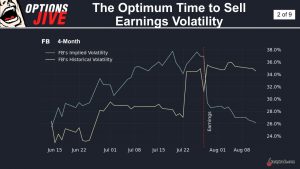The Earnings Trade: Optimal Timing for Options Sales
Implied volatility tends to get crushed after an earnings event, but research suggests that short premium trades enjoy high win rates both before after the day of earnings.

Earnings season for the third quarter of 2021 is in full swing, and over the next two weeks roughly 315 companies from the S&P 500 will release their Q3 earnings reports.
Earnings season provides investors and traders with a plethora of new opportunities because stocks often make big moves in the wake of an impacting earnings report, and that can open up attractive entry points for new positions.
Tesla (TSLA) provides a great example of this phenomenon. After releasing earnings on Oct. 20, the stock rallied in strong fashion and is currently trading about 20% higher than it was right before earnings. Bullish investors that jumped into Tesla after its earnings report have consequently benefited greatly in a very short period.
But investors and traders aren’t limited to simple directional positions when it comes to earnings. In fact, the vast majority of earnings-focused positions are deployed using equity options (aka equity derivatives).
Options unlock a whole new playbook because they allow for a wider range of position types. Of course, one can still express a simple bullish or bearish directional position with options. But beyond that, market participants can express a variety of other market outlooks.
For example, a covered call might be deployed to generate extra income on an existing long stock position, or a short straddle/strangle might be sold if one expects a stock to trade sideways after earnings.
Moreover, investors and traders can also express an opinion on implied volatility, which tends to be a big factor during earnings season.
As most traders and investors already know, implied volatility represents the current market price for volatility based on the market’s expectations for future movement in a given underlying. This value is implied by the dollar and cents value that one sees trading in the marketplace.
For example, if a hypothetical stock trading for $100/share had options trading with an implied volatility of 20%, that would imply that the market believes there’s a very strong chance the stock finishes the year trading between $80/share and $120/share. Because 20% of 100 is equal to $20, which would encompass a one standard deviation move in either direction.
When it comes to trading earnings, an important dynamic to keep in mind is the fact that implied volatility typically gets crushed in the wake of the earnings event.
This occurs because the passing of earnings theoretically removes a portion of event-risk from the market, which in turn translates to lower levels of implied volatility—especially in near-term options.
As a result, some investors/traders prefer to sell options premium in the lead-up to earnings, to try and take advantage of the crush after the event. The primary risk with this approach is that the underlying stock makes a bigger than expected move in the wake of earnings.
The chart below highlights how implied volatility tends to increase leading up to earnings, and then drop off sharply after the earnings-day event.

While the above strategy works well for many market participants, those investors and traders that don’t want to carry short options risk through earnings may decide to adopt a different approach.
According to previous research conducted by tastytrade, short options positions have performed well even after the earnings crush.
So even though implied volatility has decreased in absolute terms after the earnings event, there’s still enough juice left in the options to make them potentially attractive for selling premium.
This is true because the passing of earnings means that fewer surprises are left to be revealed—because all pertinent information on the company’s current operations was just released as a part of earnings. Many stocks trade sideways after earnings, for this very reason, which is why the historical data likely shows attractive win rates for this approach.

In sum, that means investors and traders seeking to sell premium can consider doing so both before and/or after the earnings event, depending on one’s market outlook and risk profile.
To learn more about these respective approaches to trading earnings, readers are encouraged to review the following programming on the tastytrade financial network:
- Options Jive: The Optimum Time to Sell Earnings Volatility
- Market Measures: Short Straddle Performance After Earnings
More tactical information about the earnings trade is also available on this new installment of Options Trading Concepts Live.
For timely insights on everything moving the markets, readers can also tune into TASTYTRADE LIVE—weekdays from 7 a.m. to 4 p.m. CST—at their convenience.
Sage Anderson is a pseudonym. He’s an experienced trader of equity derivatives and has managed volatility-based portfolios as a former prop trading firm employee. He’s not an employee of Luckbox, tastytrade or any affiliated companies. Readers can direct questions about this blog or other trading-related subjects, to support@luckboxmagazine.com.



















